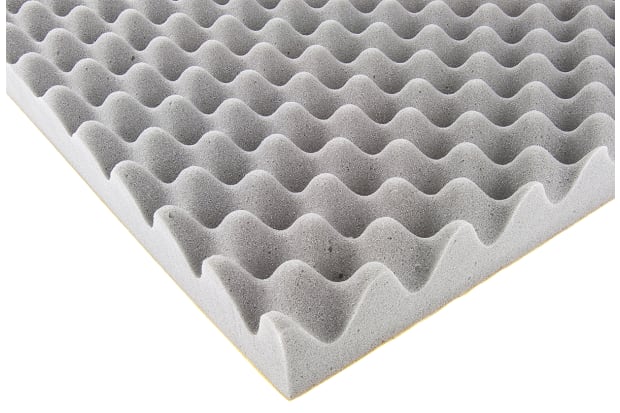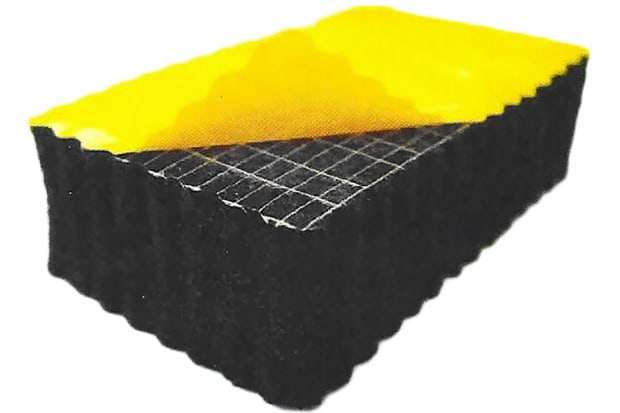- เผยแพร่เมื่อ 10 ก.พ. 2566
- แก้ไขครั้งล่าสุด 29 ส.ค. 2566
- 11 นาที
A Guide to Soundproofing Materials
What types of soundproofing materials are available? Discover how they can be used to soundproof walls and spaces.

There is a wide variety of materials that may be used for soundproofing purposes. The appropriate choice will depend on the intended minimisation or elimination of sound. Soundproofing materials are commonly installed either for the purpose of improving the sound quality within a room or reducing the level of sound leakage to adjacent rooms and areas. Soundproofing options include foam sheeting and acoustic insulation.
What is Soundproofing and How Does It Work?
Soundproofing is a method for the reduction of sound pressure in relation to a particular sound source and receptor. It may also be referred to as decibel reduction, sound insulation, or acoustic insulation. The installation of soundproofing should result in the reduction of decibels (dB) or absorption of sound. There is a variety of soundproofing materials, each suitable for distinct applications. The use of soundproofing products is recommended whenever you want to minimise the level of sound that is being generated in a different space, room, or enclosure from your own.
Soundproofing can be an effective means of suppressing unwanted indirect sound waves including the reflection of echoes, resonances, and reverberations. It can also be used to reduce the transmission of undesirable indirect sound waves that would otherwise be highly noticeable to an involuntary listener.
Soundproofing may be applied to either residential or commercial properties. In the first instance, the aim will be to reduce or completely eliminate the input of sounds from outside sources. Residential soundproofing is commonly focussed on existing structures, such as windows and doors. As a result, standard soundproofing options include the fitting of curtains and double-paned windows. Exterior windows may also be fitted for improved soundproofing in some instances.
Similarly, soundproofing can be applied to commercial buildings such as restaurants, schools and office buildings for the reduced disturbance of staff and customers. It is quite common for soundproofing technologies to be included in the design of open-plan offices to minimise noise and help with worker productivity. Such technologies might also be included in areas where confidential discussions are regularly held.
Soundproofing materials enable the minimisation of sound in the following ways:
- Blocking airborne noise through the addition of mass to a structure and resulting in the reflection or conversion of sound energy into heat
- Separating or dampening the impact noise between structures and minimising the circulation of sound vibration/energy
- Absorbing sound that would otherwise reverberate and echo within a contained space
Soundproofing Materials – What are They?
As mentioned, there is a wide variety of soundproofing materials, each suited to different applications. The best choice will depend on the desirable noise minimisation, a level which is normally indicated in the form of a dB rating. It’s also worth keeping in mind that soundproofing materials will only be as strong as their weakest point.
The dB rating typically equates to the level of sound reduction achieved on the transmission of sound through existing materials and added soundproofing. Soundproofing materials can be fitted for the effective minimisation of noise in a wide variety of environments.
Consider the varieties of soundproofing highlighted in this content:
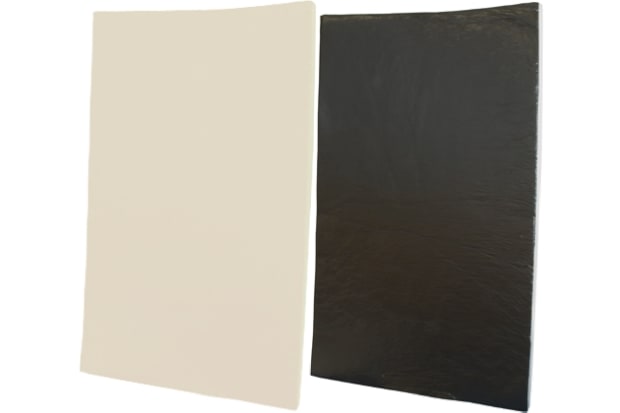
Foam soundproofing sheet
Material :
- Polyurethane foam
Benefits :
- High levels of sound absorption and insulation
- Facing protection against dust and moisture
- Chemical resistance
Typical Uses :
- Panelling of machinery
- Engine rooms
- Close-fit canopies

PVC soundproofing sheet
Material :
- Solid PVC sheeting
Benefits :
- High mass noise barrier
- Effective sound absorption and insulation
Typical Uses :
- Various domestic and commercial applications
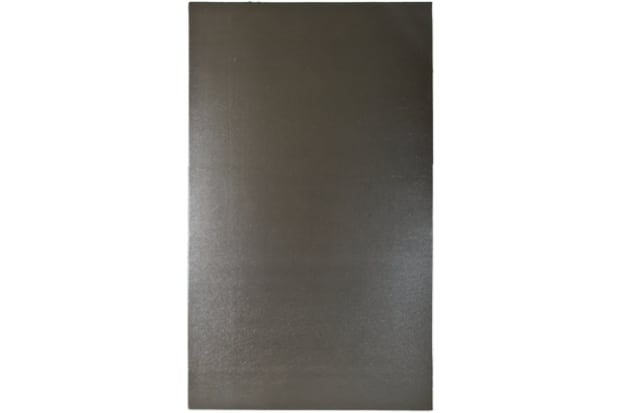
PUR soundproofing sheet
Material :
- Polyurethane foam
Benefits :
- High levels of sound absorption and insulation
- Facing protection against dust and moisture
- Resistance to chemicals
Typical Uses :
- Pump enclosures
- Engine rooms
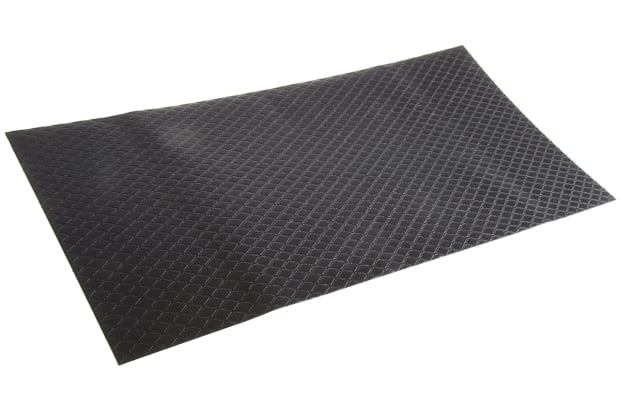
Adhesive bitumen soundproofing mat
Material :
- Black, flexible bitumen or plastic panels made to industrial standards
Benefits :
- Dampens and reduces body vibrations and air noises in metals and plastics
Typical Uses :
- Various domestic and vehicle applications
Soundproofing Foam
Soft and lightweight soundproofing foam is designed for the absorption of natural sound waves and the prevention of noises generated as a result of contact on hard surfaces (such as walls and ceilings). This involves the conversion of sound energy into heat and minimisation of the sound waves that may circulate through a room. Such foam may also be fitted for the purpose of improved sound quality, particularly within music studios. The thickness and density of the foam will have a direct bearing on the penetration of sound.
Soundproofing Foam Panels and Tiles
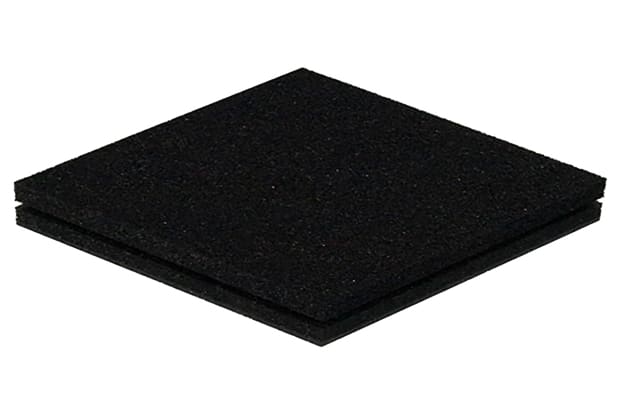
It is essential to soften hard surfaces for the effective absorption of sound within a room. This softening effect can be achieved through the installation of foam panels and the application of purpose-made tiles to the largest surface areas (floors and ceilings). Foam panels are typically fitted for the separation of the wall between rooms for prevention of sound circulation. Soundproofing foam tiles can also be cut to your specifications.
Soundproofing Panels
Soundproofing panels are ideally suited to the deadening and dampening of sound in restaurants, offices, and other types of commercial space. Such panels are made from high-density acoustic plasterboard, effectively preventing the transfer of sound between rooms. Available options include fabric-wrapped, perforated wood, and water-resistant panels, depending on your requirements. Panels like these are designed for a range of purposes including the absorption of sound waves, clarification of speech, and limitation of reverberation through interior spaces. They are equally suitable for domestic and commercial applications.
Soundproofing Sheets
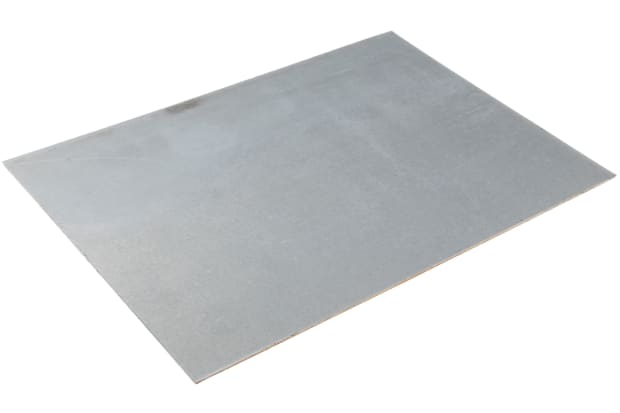
Soundproofing Sheets
You can buy soundproofing sheets complete with a variety of fill materials and facings. Each of the materials has excellent sound absorption and insulation qualities, also ensuring protection against the ingress of dust and moisture. Some of these sheets also feature adhesive backing for secure attachment to machinery and equipment.
How to Soundproof Walls
There are two main varieties of wall that people are commonly keen to soundproof. The first type is the solid standard party wall, constructed with a brick or block formation. The other type is the internal stud wall, usually consisting of a timber frame and plasterboard insulation. Higher levels of soundproofing are typically required for properties featuring stud walls. It is quite common to fit soundproof panels and construct acoustic walls for soundproofing against noisy neighbours. Such methods may also be used to effectively soundproof a bedroom.
The first key step when soundproofing a stud wall will be to carry out a check for any gaps or weak points. These can be filled with acoustic sealant for improved security. The process may then continue with the improvement of walling mass and the addition of acoustic insulation between the timber battens. It is advisable to use a combination of materials for the limitation of noise at different frequencies.
Soundproofing a Wall
The highest level of soundproofing can be achieved by creating a room within a room, separate from the external structure. This may also be referred to as acoustic de-coupling. It involves the elimination of vibration transferred between solid materials and through the air. However, it is important to account for safety implications, ensuring a reasonable degree of ventilation and avoiding the use of gas heaters.
Alternative methods for soundproofing walls include the installation of thin sound panels and complete acoustic wall systems. Soundproofing panels allow for the effective minimisation of sound without the need to sacrifice any interior space. However, a combination of materials should be used in instances requiring a high degree of soundproofing. High density acoustic insulation slabs can be fitted for sound absorption and the limitation of reverberation. You also have the option of fitting stud walling, with different levels of thickness and insulation to suit the depth of existing stud walls.
How to Soundproof a Room
You might be keen to soundproof an entire room for a range of reasons. It might be that you want to create a separate creative space, where you can maintain full concentration without disturbance. Alternatively, you might be creating a home entertainment space, in which the sound should be fully enclosed. Whatever the case, there is a range of soundproofing options to consider.
The process of soundproofing a room should begin with the identification of any noise sources. This will have a bearing on the appropriate choice of soundproofing solution. The variety and intensity of the noise should also be taken into account. Different soundproofing materials are suited to solid and stud walls, as explained above.
The first step in the soundproofing installation process will be to add mass to the walls. This might involve the addition of recycled cotton batts or sound isolation systems. The ceiling should be the next area of the room to be soundproofed. Soundproofing insulation may be fitted between the joists of a ceiling in the process of construction. Alternatively, acoustic panels may be fitted between the tracks of the soundproofing system of an existing ceiling.
Ideally, it will be possible to soundproof the floor from above. The installation of acoustic flooring will allow for the most effective minimisation of noise produced when people walk or move furniture across the floor. Improved soundproofing can be achieved through the installation of acoustic floating floors.
What are the Different Types of Noise?
There are three primary types of sound that can be minimised with soundproofing materials.
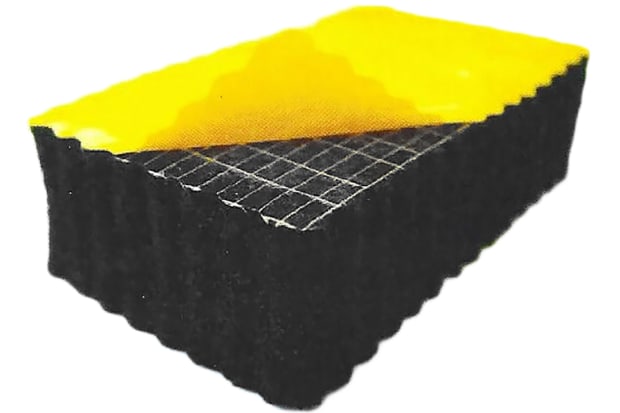
Airborne Noise
Airborne noise is quite simply noise transmitted through the air. It might be generated by everything from a television to a barking dog. The production of airborne and structural sounds is often connected, with one causing the other. It will be necessary to install a barrier or insulation material for the effective minimisation of airborne noise. The density and thickness will have a direct bearing on the soundproofing effectiveness of such materials.

Impact Noise
Impact noises are generated as a result of firm connection between different types of material. As an example, there will be a high-level impact noise when hammering a nail into a wall. Such sounds can be minimised through the placement of a barrier between the materials. Other options include the installation of floating floors and acoustic ceiling systems.
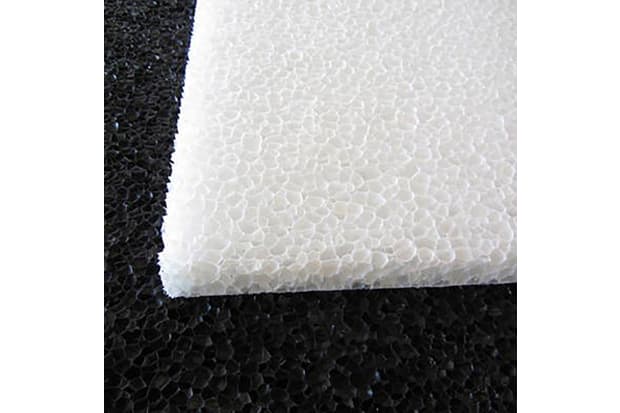
Structure-Borne Noise
Structure-borne noise is transmitted via the structure of a building. It will occur as a result of sound being generated via an adjacent vibrating surface. A good example is footsteps on a floor being heard in the room below. As previously mentioned, structure-borne noise can result in airborne noise and vice versa.
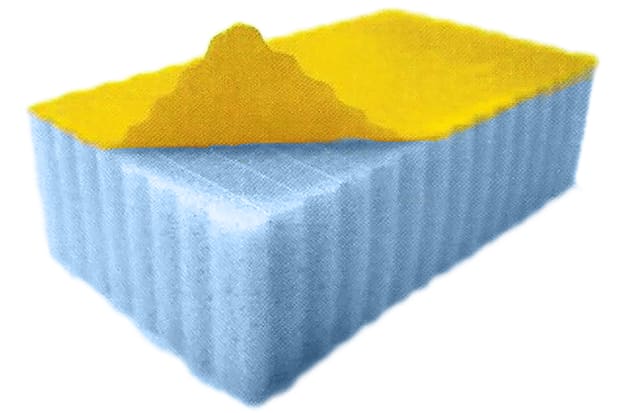
Flanking Noise
It is common to encounter flanking noise in flats, where the sound is transmitted through the fabric of the building. It is typically a result of impact noise and circulates through the interior walls. Flanking will be a particular issue if the walls are made from lightweight material. Modern flats are commonly constructed from high density blocks for this reason. Blocks with a density of at least 7 kilonewtons should be used for the effective minimisation of flanking noise and to ensure compliance with UK building regulations.
How to Measure Sound
How to Measure Sound
A variety of factors may have a bearing on perceived and actual levels of sound. The period of exposure, frequencies (or pitches), and the environment will all have some impact. Sound intensity (otherwise referred to as sound power or pressure) is measured in decibels (dB). You should be aware that sound is measured in logarithmic terms, relating to the physical sensation felt upon hearing. A gradual increase in sound level will result in greatly increased intensity and perceived loudness.
Sound levels may also be measured in terms of weighted decibels (dBA). Such measurement is directly associated with the impact on hearing health. It relates specifically to the intensity of sound and impact on the human ear. Small increases in the dBA level can have a significant impact on your hearing.
There will be a greater risk of hearing damage on exposure to:
- 85 dBA for a period of at least 8 hours
- 100 dBA for at least 14 minutes
- 110 dBA for at least 2 minutes
The frequency of sound is measured in terms of the number of sound vibrations per second. A person with optimum ear health can hear sounds of frequencies between 20 Hertz and 20,000 Hertz. There are various types of electronic equipment that can be used for the purpose of measuring sound levels in dB and dBA.
Popular Brands
Paulstra Hutchinson
From acoustic foam to soundproofing sheets and more, explore our range of Paulstra Hutchinson soundproofing products.
RS PRO
See our extensive selection of RS PRO soundproofing products and discover the perfect fit for your project.
